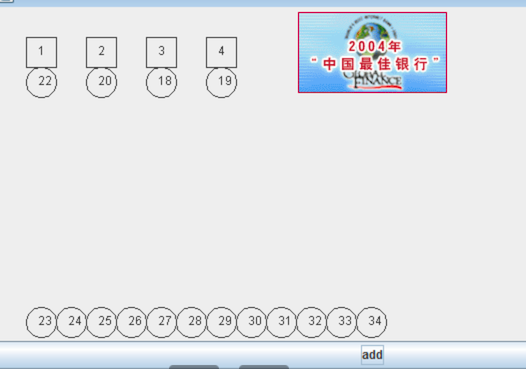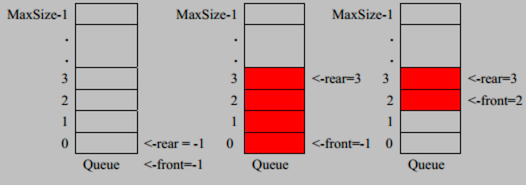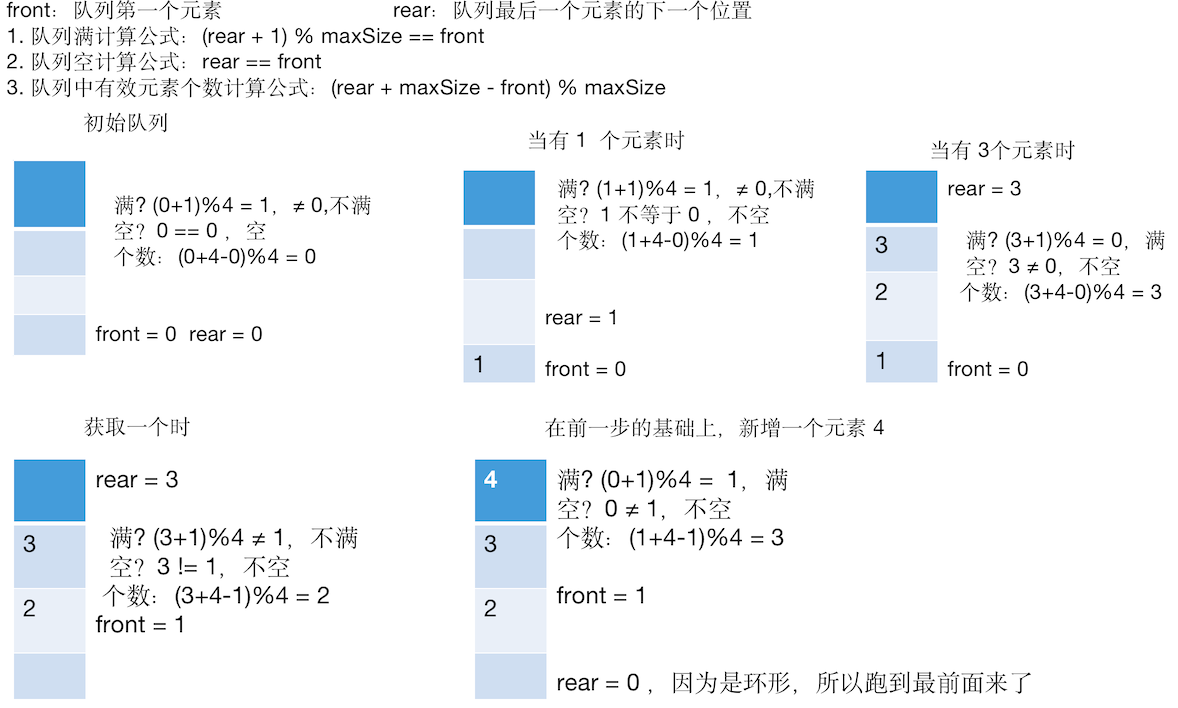# 队列
# 一个使用场景
银行办理业务的排队叫号

办理业务的人先拿号,然后窗口叫号处理,没有叫到的,则排队等待。
# 基本介绍
队列:是一个 有序列表,可以用 数组 或 链表 实现。
特点:遵循 先入先出 原则。即:先存入的数据,先取出。
示意图:

- front:队首,队列头部
- rear:队尾,队列尾部
- 左 1 图:队列初始化的两个变量值
- 中图:存入数据后,的首位变化
- 右图:取数据时,从队首取,队首的变量指向也在发生变化
# 数组模拟队列
队列本身是 有序列表,使用数组结构来存储队列的数据,则如前面基本介绍中的示意图一样。
声明 4 个变量:
- arr:用来存储数据的数组
- maxSize:该队列的最大容量
- front:队首下标,随着数据输出而改变
- rear:队尾下标,随着数据输入而改变
队列中常用操作分析,以 add,把数据存入队列为例,思路分析:
- 将尾指针往后移:rear + 1,前提是当 front == rear 时,队列是空的
- 若尾指针 rear < maxSize -1:
- 则将数据存入 rear 所指的数组元素中,
- 否则无法存入数据。rear = maxSize -1 表示队列满了
以上思路是一个最基本的实现(不是完美的,看完代码就明白了)。代码实现如下
package cn.mrcode.study.dsalgtutorialdemo.datastructure.queue;
/**
* 数组模拟队列
*/
public class ArrayQueueDemo {
public static void main(String[] args) {
ArrayQueue queue = new ArrayQueue(3);
queue.add(1);
queue.add(2);
queue.add(3);
System.out.println("查看队列中的数据");
queue.show();
System.out.println("查看队列头数据:" + queue.head());
System.out.println("查看队列尾数据:" + queue.tail());
// queue.add(4);
System.out.println("获取队列数据:" + queue.get());
System.out.println("查看队列中的数据");
queue.show();
}
}
class ArrayQueue {
private int maxSize; // 队列最大容量
private int front; // 队列头,指向队列头的前一个位置
private int rear; // 队列尾,指向队列尾的数据(及最后一个数据)
private int arr[]; // 用于存储数据,模拟队列
public ArrayQueue(int arrMaxSize) {
maxSize = arrMaxSize;
arr = new int[maxSize];
front = -1;
rear = -1;
}
/**
* 取出队列数据
*/
public int get() {
if (isEmpty()) {
throw new RuntimeException("队列空");
}
return arr[++front];
}
/**
* 往队列存储数据
*/
public void add(int n) {
if (isFull()) {
System.out.println("队列已满");
return;
}
arr[++rear] = n;
}
/**
* 显示队列中的数据
*/
public void show() {
if (isEmpty()) {
System.out.println("队列为空");
return;
}
for (int i = 0; i < arr.length; i++) {
System.out.printf("arr[%d] = %d \n", i, arr[i]);
}
}
/**
* 查看队列的头部数据,注意:不是取出数据,只是查看
*
* @return
*/
public int head() {
if (isEmpty()) {
throw new RuntimeException("队列空");
}
return arr[front + 1]; // front 指向队列头前一个元素,取头要 +1
}
/**
* 查看队尾数据
*
* @return
*/
public int tail() {
if (isEmpty()) {
throw new RuntimeException("队列空");
}
return arr[rear];
}
// 队列是否已满
private boolean isFull() {
return rear == maxSize - 1;
}
// 队列是否为空
private boolean isEmpty() {
return rear == front;
}
}
2
3
4
5
6
7
8
9
10
11
12
13
14
15
16
17
18
19
20
21
22
23
24
25
26
27
28
29
30
31
32
33
34
35
36
37
38
39
40
41
42
43
44
45
46
47
48
49
50
51
52
53
54
55
56
57
58
59
60
61
62
63
64
65
66
67
68
69
70
71
72
73
74
75
76
77
78
79
80
81
82
83
84
85
86
87
88
89
90
91
92
93
94
95
96
97
98
99
100
101
102
103
104
105
运行测试
查看队列中的数据
arr[0] = 1
arr[1] = 2
arr[2] = 3
查看队列头数据:1
查看队列尾数据:3
获取队列数据:1
查看队列中的数据
arr[0] = 1
arr[1] = 2
arr[2] = 3
2
3
4
5
6
7
8
9
10
11
# 问题分析
目前实现了一个 一次性的队列(不能复用),因为可以往队列中添加数据,基本功能也是可以的,当队列满之后,再添加就加不进去了,获取数据也不能清空原队列中的数据。
优化方向:使用算法将这个数组改进成一个环形队列。
# 数组模拟环形队列
# 思路分析

front:含义调整
表示:队列的第一个元素,也就是说
arr[front]就是队列的第一个元素初始值:0
rear:含义调整
表示:队列的最后一个元素的下一个位置
初始值:0
这个很重要,是一个小算法,能更方便的实现我们的环形队列。
队列 满 计算公式:
(rear + 1) % maxSize == front队列 空 计算公式:
rear == front队列中 有效元素个数 计算公式:
(rear + maxSize - front) % maxSize
为了能更清晰这个算法,下面画图来演示队列中元素个数,关键变量的值

该算法取巧的地方在于 rear 的位置,注意看上图,rear 所在的位置 永远是空的,实现环形队列的算法也有多种,这里空出来一个位置,是这里算法的核心。
# 代码实现
package cn.mrcode.study.dsalgtutorialdemo.datastructure.queue;
import java.util.Scanner;
/**
* 数组拟环形队列
*/
public class CircleQueueDemo {
public static void main(String[] args) {
CircleQueue queue = new CircleQueue(3);
// 为了测试方便,写一个控制台输入的小程序
Scanner scanner = new Scanner(System.in);
boolean loop = true;
char key = ' '; // 接受用户输入指令
System.out.println("s(show): 显示队列");
System.out.println("e(exit): 退出程序");
System.out.println("a(add): 添加数据到队列");
System.out.println("g(get): 从队列取出数据");
System.out.println("h(head): 查看队列头的数据");
System.out.println("t(tail): 查看队列尾的数据");
System.out.println("p(isEmpty): 队列是否为空");
while (loop) {
key = scanner.next().charAt(0);
switch (key) {
case 's':
queue.show();
break;
case 'e':
loop = false;
break;
case 'a':
System.out.println("请输入要添加到队列的整数:");
int value = scanner.nextInt();
queue.add(value);
break;
case 'g':
try {
int res = queue.get();
System.out.printf("取出的数据是:%d\n", res);
} catch (Exception e) {
System.out.println(e.getMessage());
}
break;
case 'h':
try {
int res = queue.head();
System.out.printf("队首数据:%d\n", res);
} catch (Exception e) {
System.out.println(e.getMessage());
}
break;
case 't':
try {
int res = queue.tail();
System.out.printf("队尾数据:%d\n", res);
} catch (Exception e) {
System.out.println(e.getMessage());
}
break;
case 'p':
System.out.printf("队列是否为空:%s", queue.isEmpty());
break;
}
}
}
}
class CircleQueue {
private int maxSize; // 队列最大容量
private int front; // 队列头,指向 队头 的元素
private int rear; // 队列尾,指向 队尾 的下一个元素
private int arr[]; // 用于存储数据,模拟队列
public CircleQueue(int arrMaxSize) {
maxSize = arrMaxSize + 1;
arr = new int[maxSize];
front = 0;
rear = 0;
}
/**
* 取出队列数据
*/
public int get() {
if (isEmpty()) {
throw new RuntimeException("队列空");
}
// front 指向的是队首的位置
int value = arr[front];
// 需要向后移动,但是由于是环形,同样需要使用取模的方式来计算
front = (front + 1) % maxSize;
return value;
}
/**
* 往队列存储数据
*/
public void add(int n) {
if (isFull()) {
System.out.println("队列已满");
return;
}
arr[rear] = n;
// rear 指向的是下一个位置
// 由于是环形队列,需要使用取模的形式来唤醒他的下一个位置
rear = (rear + 1) % maxSize;
}
/**
* 显示队列中的数据
*/
public void show() {
if (isEmpty()) {
System.out.println("队列为空");
return;
}
// 打印的时候,需要从队首开始打印
// 打印的次数则是:有效的元素个数
// 获取数据的下标:由于是环形的,需要使用取模的方式来获取
for (int i = front; i < front + size(); i++) {
int index = i % maxSize;
System.out.printf("arr[%d] = %d \n", index, arr[index]);
}
}
/**
* 查看队列的头部数据,注意:不是取出数据,只是查看
*
* @return
*/
public int head() {
if (isEmpty()) {
throw new RuntimeException("队列空");
}
return arr[front];
}
/**
* 查看队尾数据
*
* @return
*/
public int tail() {
if (isEmpty()) {
throw new RuntimeException("队列空");
}
// rear - 1 是队尾数据,但是如果是环形收尾相接的时候
// 那么 0 -1 就是 -1 了,负数时,则是数组的最后一个元素
return rear - 1 < 0 ? arr[maxSize - 1] : arr[rear - 1];
}
// 队列是否已满
private boolean isFull() {
return (rear + 1) % maxSize == front;
}
// 队列是否为空
public boolean isEmpty() {
return rear == front;
}
// 有效个数
public int size() {
return (rear + maxSize - front) % maxSize;
}
}
2
3
4
5
6
7
8
9
10
11
12
13
14
15
16
17
18
19
20
21
22
23
24
25
26
27
28
29
30
31
32
33
34
35
36
37
38
39
40
41
42
43
44
45
46
47
48
49
50
51
52
53
54
55
56
57
58
59
60
61
62
63
64
65
66
67
68
69
70
71
72
73
74
75
76
77
78
79
80
81
82
83
84
85
86
87
88
89
90
91
92
93
94
95
96
97
98
99
100
101
102
103
104
105
106
107
108
109
110
111
112
113
114
115
116
117
118
119
120
121
122
123
124
125
126
127
128
129
130
131
132
133
134
135
136
137
138
139
140
141
142
143
144
145
146
147
148
149
150
151
152
153
154
155
156
157
158
159
160
161
162
163
164
165
166
167
运行测试功能输出
s(show): 显示队列
e(exit): 退出程序
a(add): 添加数据到队列
g(get): 从队列取出数据
h(head): 查看队列头的数据
t(tail): 查看队列尾的数据
p(isEmpty): 队列是否为空
a
请输入要添加到队列的整数:
10
a
请输入要添加到队列的整数:
20
a
请输入要添加到队列的整数:
30
s
arr[0] = 10
arr[1] = 20
arr[2] = 30
a
请输入要添加到队列的整数:
40
队列已满
h
队首数据:10
t
队尾数据:30
g
取出的数据是:10
s
arr[1] = 20
arr[2] = 30
a
请输入要添加到队列的整数:
40
s
arr[1] = 20
arr[2] = 30
arr[3] = 40
h
队首数据:20
t
队尾数据:40
g
取出的数据是:20
s
arr[2] = 30
arr[3] = 40
a
请输入要添加到队列的整数:
50
s
arr[2] = 30
arr[3] = 40
arr[0] = 50
h
队首数据:30
t
队尾数据:50
2
3
4
5
6
7
8
9
10
11
12
13
14
15
16
17
18
19
20
21
22
23
24
25
26
27
28
29
30
31
32
33
34
35
36
37
38
39
40
41
42
43
44
45
46
47
48
49
50
51
52
53
54
55
56
57
58
59
60
可以看到上面的表现,和那个图解分析是一致的, real 所在的位置没有元素,是动态的
← 稀疏数组 链表 Linked List →